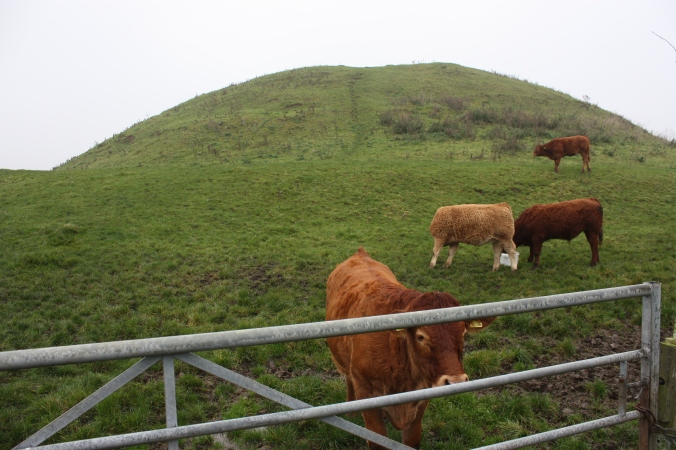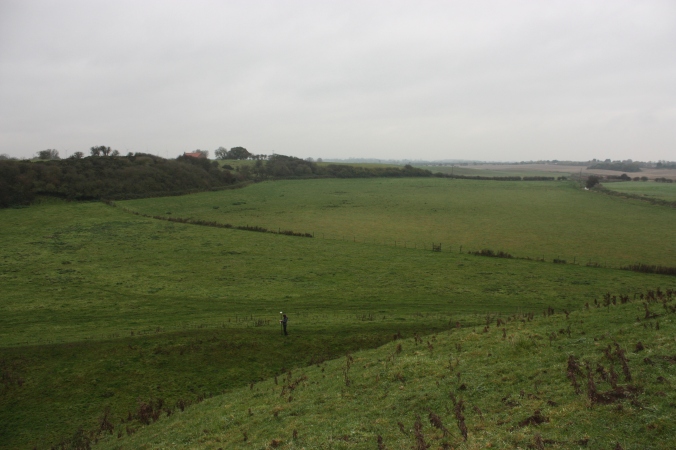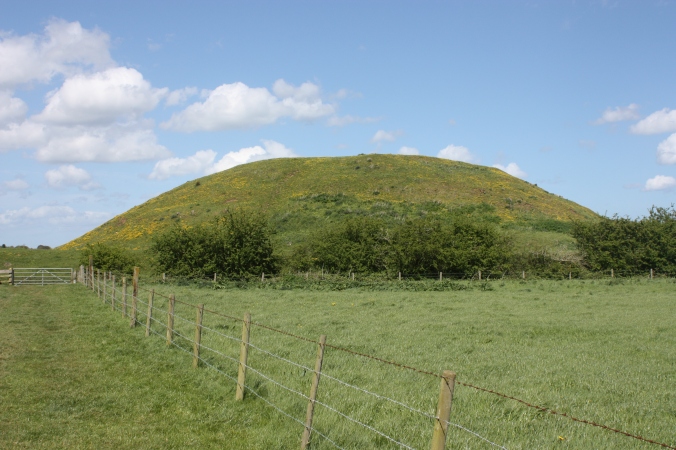On the low-lying plain of Holderness in East Yorkshire lie the impressive remains of Skipsea Castle. The site was investigated by the Round Mounds Project team during our first season of fieldwork with quite extraordinary results…
Holderness is a rural, gently undulating landscape bounded by the dip slope of the Yorkshire Wolds to the north and west, and the large expanse of the Humber Estuary to the south. To the east lies the soft boulder clay cliffs of a coastline being rapidly eroded by the power of the North Sea. Skipsea Castle is situated 12km south of Bridlington, in an area formed primarily from glacial deposits of clay, sand and gravel which carpet the underlying Cretaceous Chalk strata.
Documentary history of Skipsea Castle
The history and development of Skipsea Castle is not well documented. Construction of the castle was begun by Drogo de la Beauvrière, the first of the lords of Holderness, sometime between 1071 and 1086. Skipsea Castle served as the principal seat of the medieval lordship of Holderness until it was replaced by the manor house at Burstwick, probably before 1200. A borough at Skipsea is first referred to between 1160 and 1175 and is assumed to be a foundation of Count William le Gros who succeeded to the lordship of Holderness in 1135.

Skipsea Castle motte and the cattle that call it home
The castle earthworks comprise an impressive earthen mound or motte which measures 85m across at its base and stands 13m high. The motte is surrounded by an oval ditch and outer bank, with a large enclosure or bailey extending to the south. The low-lying area to the north and north-west represents the bed of a former post-glacial natural lake named Skipsea Mere. Lakes and marshland were once common in the Holderness landscape, with the mere at Skipsea reportedly drained by the early 18th century. To the south-west of the mound is a further enclosure, defined on three sides by a substantial earthen bank, and interpreted in the past as the site of the planted settlement of Skipsea Brough.

The massive earthwork banks of “Skipsea Brough” as seen from the top of Skipsea Castle motte.

View of Skipsea mere – a former lake drained in the 18th century – as seen from the top of the mound.
The Round Mounds team investigate…
In November 2015 the Round Mounds team removed two continuous cores from the mound at Skipsea. These revealed that it was constructed on a natural rise in the grounds surface, with only the top 8m of the mound manmade. The mound, composed of glaciofluvial deposits, was therefore carefully sculpted from a low ridge, the unusual form of the surrounding ditch dictated by the natural topography. There was nothing visible in the core material or the earthwork remains to suggest phasing in the mounds construction, suggesting the main body of the monument was created in a single construction episode.

Drilling in the rain at Skipsea – thankfully it was worth it in the end!
An extraordinary discovery
Radiocarbon dates revealed it was constructed in the middle Iron Age – 1,500 years older than previously thought. The scale of the mound at Skipsea makes it a unique monument in Iron Age Britain.
Back in the laboratory at the University of Reading charcoal was extracted from the mound material and sent to SUERC in East Kilbride, Scotland, for radiocarbon dating. The dates these samples returned were quite extraordinary and rather unexpected. Charcoal from both the buried ground surface and the makeup of the mound revealed it was constructed some time around 400-200 BC in the middle Iron Age, and was therefore almost 1,500 years older than previously thought. The scale of the mound at Skipsea makes it a unique monument in Iron Age Britain, with the nearest comparable mounds found in continental Europe. This new discovery also has implication for the interpretation of the wider castle site, as well as the broader Holderness landscape.

Skipsea – the largest Iron Age mound in England?
Fieldwork for the Round Mounds Project continues – how many more previously unrecognised prehistoric monuments are hiding from us in plain sight?
More about the discovery at Skipsea in the media:
https://www.theguardian.com/science/2016/oct/03/skipsea-castle-yorkshire-built-on-iron-age-mound
Congratulations! That’s a stunning discovery!
LikeLiked by 1 person
Thanks! Must say we were pretty surprised! The whole site is really really fascinating. Definitely so much more to be done at Skipsea, I think.
LikeLike
It’s one to add to my visiting list, I feel 🙂 Just waiting to what the other samples show now from the rest of the sites.
LikeLike
Pingback: Discovery | Sue Vincent – Daily Echo
Pingback: The Mount, Lewes: ancient monument, medieval fortification… or garden feature? | The Round Mounds Project
Marvellous discovery. Many congratulations to the team. I am looking forward to the next stage in the story of Skipsea – it could be fantastic. Are you looking at other mounds within Wessex ? Possibly the one at Mere – lots of prehistoric activity within the area.
LikeLike
Pingback: Radiocarbon dates from 10 castle mounds – results of year 1 | The Round Mounds Project
Pingback: Discovery – France & Vincent